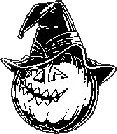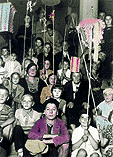FOLKLORISTIC in Florence
THE HISTORIC GAME OF "CALCIO IN COSTUME"

The game of Calcio in Costume
bears no resemblance to football, although calcio is Italian for football,
or soccer. It was probably invented in the military encampments where
the soldiers resting between battles would have lost strength without
exercise. Here was a game which developed arm and leg muscles in a real
hand to hand struggle for what was the size and shape of a cannon ball.
It was first played in Florence not so much as a sport as for training
young men in the art of combat. The most famous match was probably that
played on 17 February 1530, in Piazza Santa Croce. The Florentines had
taken advantage of the sack of Rome by the imperial armies in 1527 to
drive the Medici out of the city for a second time and place themselves
under the sovereignty of Christ and the Virgin, determined to defend
Florence to the last against the imperial armies spurred on by Pope
Clement VII. The imperial army, the most powerful of the time, laid
siege to Florence from the summer 1529 to that of the following year.
It was a memorable siege , which became steadily more severe, the city
began to feel the shortage of food, although the general feeling in
the city at that time was summed up by the graffiti on the walls; poor
but free. It is in this atmosphere that a game of Calcio in Costume
was played in mid-February, not just to keep up the ancient tradition
of playing during carnival but more to show the city's scorn for the
besieging troops, who considered Florence exhausted and already defeated.To
emphasize this scorn a group of Florentine musicians played from the
roof of Santa Croce so that the enemy would have a better idea of what
was going on. Suddenly a cannon ball from the imperial batteries flew
over the heads of the musicians and landed on the other side of the
church; no damage was done, and it was greeted by the jeers of the crowds
and the clamour of the instruments.  There
are no records of who won the match, maybe because it seemed more of
a joint effort against the enemy than a tournament amongst teams. Although
the match was a success, the city soon capitulated and the iron rule
of the Medici returned.
There
are no records of who won the match, maybe because it seemed more of
a joint effort against the enemy than a tournament amongst teams. Although
the match was a success, the city soon capitulated and the iron rule
of the Medici returned.
The matches were played almost
without interruption until the end of the 18th century, and only in
May 1930 on the fourth centenary of the siege of Florence was the historical
manifestation started up again. Nowadays three matches are played, by
teams drawn from Florence's four major neighborhoods, in Piazza Santa
Croce, on 16th, 24th, 30th of June on the recurrence of the patron -saint.
After the long parade headed by the nobles on horseback, starting in
Santa Maria Novella and culminating in Piazza Santa Croce, the game
begins to cries of Viva Firenze! It is an hour of continuous struggle,
attacks, scuffles, blows and tangling of bodies dressed in fifteenth-century
costumes. It is intended to echo the famous match of 1530, in the desire
to revive and to record a memorable page of the city's glorious history.
LO "SCOPPIO DEL CARRO" (The burst of the Cart)

Every year on Easter Sunday Florence
hosts the Scoppio del Carro, the explosion of the carriage. This
harks back to when the Holy Fire was sparked off by using stone
chippings from the Holy Sepulchre, and it was customary to then
use it to rekindle the flame of all the hearths in the town.
Subsequently the Ceremony has
become symbolical, and now on Easter Sunday a great Chariot, which
goes back to the eighteenth century, is drawn by white oxen festooned
with garlands, and is paraded along the streets to the Cathedral
Square from Porta a Prato, where it is kept for the other 364 days
of the year. A steel wire connects it to the High Altar in the Cathedral.
During Midday Mass when the time comes for the Gloria in Excelsis
the Cardinal Archbishop lights a rocket in the form of a dove with
the holy fire obtained by means of the ancient chippings. The rocket
shoots down the wire to the Chariot stuffed full with firecrackers,
which thus explodes to the great joy of the onlookers.
"RIFICOLONA"

Ona, Ona, Ona!
Ona, Ona,
Ona,
O che bella Rificolona,
La mia l'é coi fiocchi,
La tua l'é coi pidocchi!
(Ona, ona,
ona,
What a beautiful Rificolona,
Mine with bows is tied,
In yours do lice reside!)
Florentine children sing this song as
they wander through the streets of Florence the first week of September,
carrying papier-mâché lanterns tied to the ends of sticks, called rificolone.
There are several theories as to where the tradition originates from,
some think it commemorates the triumphant entry of Florentine troops
into Siena on August 2 1555, when the soldiers tied lanterns onto the
ends of their pikes.
More probably the Festa della Rificolona grew out of the great autumn
market held on September 7, the day before the Nativity of the Virgin,
in Piazza Santissima Annunziata. It was probably the most important
market-day of the year for the farmers as it was their last chance to
earn money in preparation for the coming winter: In order to arrive
early the inhabitants of the outlying regions would set off long before
dawn and carry lanterns, made by suspending candles within tissue-paper
wind-shades, to light their way. Entire families would come, dressed
in their Sunday best, but they were ignorant country folk and their
attempts at elegance only made the city people laugh in fact Florentines
still call an overdressed, over made-up woman a rificolona. Children
would blow whistles at them, and make their own lanterns with colored
tissue paper to follow along, or shoot at the farmers' lanterns with
blowguns, in an attempt to knock over the candles and set the tissue
paper ablaze.
The market still exists today in the form of a huge fair in Piazza Santissima
Annunziata on the 6th and 7th September; it was the first fair held
by organic producers in Italy, and remains one of the most important,
with wonderful foods and performers of all kinds. Florentine children
still get out their lanterns in the beginning of September and there
are parties in the squares, with street theater and music. The Festa
della Rificolona closes with a procession on the night of the 7th, from
Piazza Santa Croce to Piazza Santissima Annunziata, which is led by
the Cardinal; he addresses the crowd, then there's a final party in
the streets until the early hours of the morning.
FESTA DI SAN GIOVANNI

Florence, June 24 is the Festa di
San Giovanni. Florence's patron Saint's day is a local holiday
which coincides with the finale of the Calcio in Costume, a spirited
medieval version of football, or soccer, in Piazza Santa Croce.
At 10pm there is a fireworks display; the best place to watch
them from is Ponte Santa Trinita, in this way the Ponte Vecchio
will be in the foreground, with the fireworks display providing
a colourful and spectacular backdrop.
Other Folkloristic events in Florence:
- Festa del Grillo
Address: Cascine (a Florentine park) - La
Fiorita
Address: Piazza della Signoria


 German
German French
French Spanish
Spanish Italian
Italian Portuguese
Portuguese Czech
Czech Japanese
Japanese